牛津版七年级英语阅读课教学设计UNIT 7 reading A
- 格式:doc
- 大小:69.00 KB
- 文档页数:5
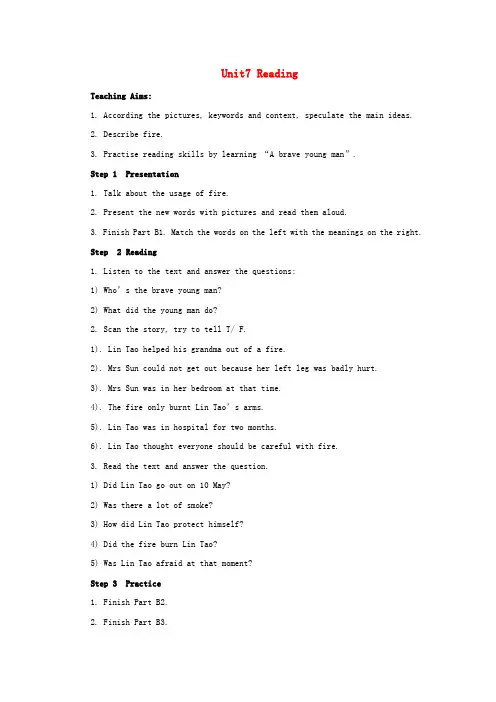
Unit7 ReadingTeaching Aims:1. According the pictures, keywords and context, speculate the main ideas.2. Describe fire.3. Practise reading skills by learning “A brave young man”.Step 1 Presentation1. Talk about the usage of fire.2. Present the new words with pictures and read them aloud.3. Finish Part B1. Match the words on the left with the meanings on the right. Step 2 Reading1. Listen to the text and answer the questions:1) Who’s the brave young man?2) What did the young man do?2. Scan the story, try to tell T/ F.1). Lin Tao helped his grandma out of a fire.2). Mrs Sun could not get out because her left leg was badly hurt.3). Mrs Sun was in her bedroom at that time.4). The fire only burnt Lin Tao’s arms.5). Lin Tao was in hospital for two months.6). Lin Tao thought everyone should be careful with fire.3. Read the text and answer the question.1) Did Lin Tao go out on 10 May?2) Was there a lot of smoke?3) How did Lin Tao protect himself?4) Did the fire burn Lin Tao?5) Was Lin Tao afraid at that moment?Step 3 Practice1. Finish Part B2.2. Finish Part B3.Step 4 SummarySum up the text.Step 5 Discussion1. Finish Part C: How to be careful with fire.2. Present the pictures and rules about fire safety.Step6 Homework1. Read aloud the article and underline the difficult parts.2. Remember the new words and phrases in this lesson.。
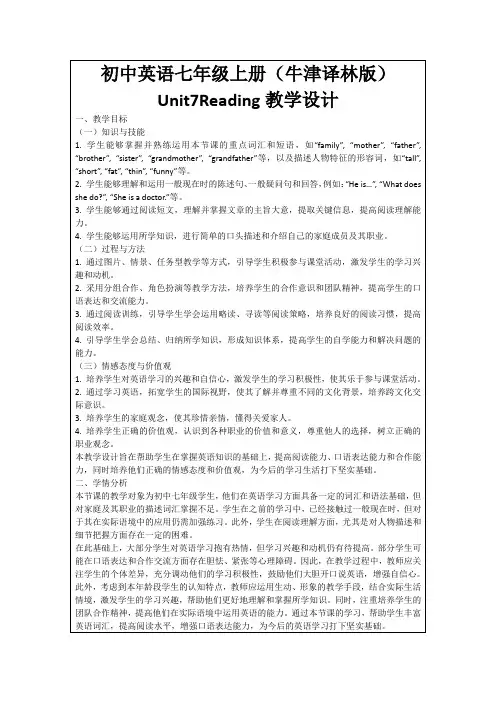
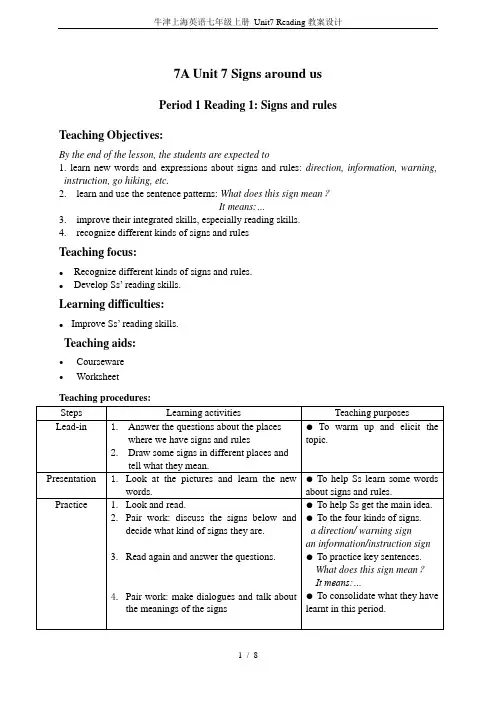
7A Unit 7 Signs around usPeriod 1 Reading 1: Signs and rulesTeaching Objectives:By the end of the lesson, the students are expected to1. learn new words and expressions about signs and rules: direction, information, warning, instruction, go hiking, etc.2. learn and use the sentence patterns: What does this sign mean?It means:…3. improve their integrated skills, especially reading skills.4. recognize different kinds of signs and rulesTeaching focus:●Recognize different kinds of signs and rules.●Develop Ss’ reading skills.Learning difficulties:●Improve Ss’ reading skills.Teaching aids:•Courseware•WorksheetTeaching procedures:教后记:本节课中对于四个标志的归纳是一个难点,学生们对于两种标志存在理解上的混淆:an information sign和an instruction sign. 指导的时候可以从他们的英文解释作为突破口。
7A Unit 7 Signs around usPeriod 2 Reading 2: Signs and rulesTeaching Objectives:By the end of the lesson, the students are expected to1. learn new words and expressions about signs and rules: useful, shelter, turn left, keep quiet, etc.2. learn and use modal verbs to express obligation and prohibition: We must…We mustn’t…3. develop the ability of reading.4. know more signs in life and obey the rules.Teaching focus:●learn and use modal verbs to express obligation and prohibition.●Learning difficulties:Improve the ability of reading.Teaching aids:•Courseware•WorksheetTeaching procedures:教后记:本节课中,重点除了四种标志的归纳外,情态动词的用法也是难点之一。
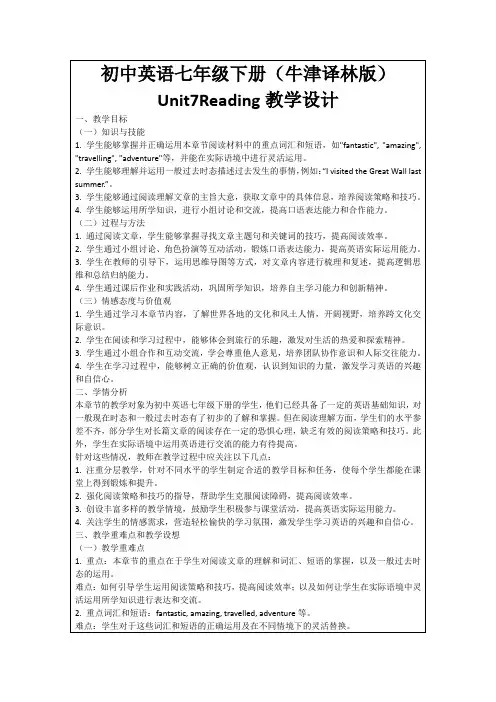
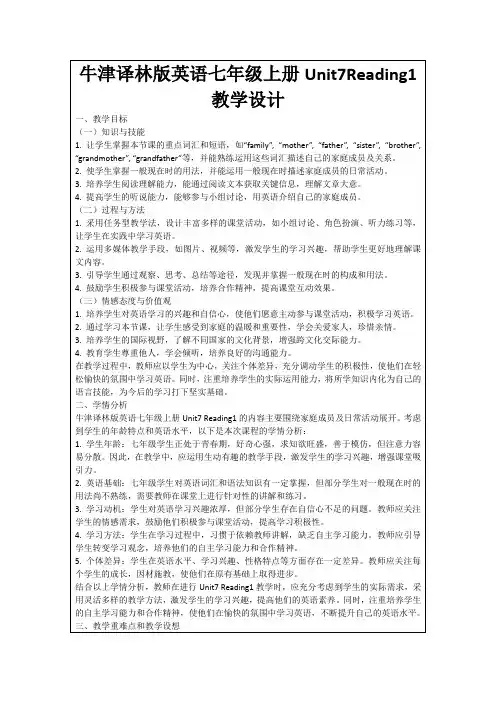
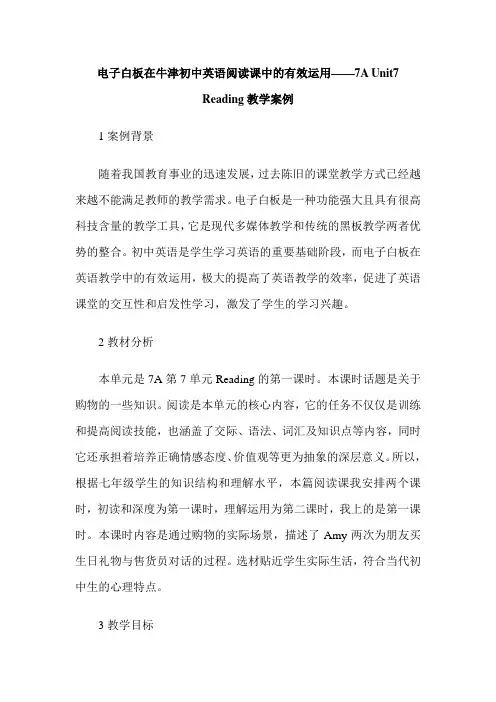
电子白板在牛津初中英语阅读课中的有效运用——7A Unit7Reading教学案例1案例背景随着我国教育事业的迅速发展,过去陈旧的课堂教学方式已经越来越不能满足教师的教学需求。
电子白板是一种功能强大且具有很高科技含量的教学工具,它是现代多媒体教学和传统的黑板教学两者优势的整合。
初中英语是学生学习英语的重要基础阶段,而电子白板在英语教学中的有效运用,极大的提高了英语教学的效率,促进了英语课堂的交互性和启发性学习,激发了学生的学习兴趣。
2教材分析本单元是7A第7单元Reading的第一课时。
本课时话题是关于购物的一些知识。
阅读是本单元的核心内容,它的任务不仅仅是训练和提高阅读技能,也涵盖了交际、语法、词汇及知识点等内容,同时它还承担着培养正确情感态度、价值观等更为抽象的深层意义。
所以,根据七年级学生的知识结构和理解水平,本篇阅读课我安排两个课时,初读和深度为第一课时,理解运用为第二课时,我上的是第一课时。
本课时内容是通过购物的实际场景,描述了Amy两次为朋友买生日礼物与售货员对话的过程。
选材贴近学生实际生活,符合当代初中生的心理特点。
3教学目标3.1知识目标:①通过阅读文章,理解并熟读其中的生词及词组。
②初步理解购物时与售货员之间的实际交际用语。
3.2能力目标:①运用听力训练,学会寻找关键词,迅速并准确找到所需信息。
②运用快速阅读和精读技巧,掌握课文内容。
3.3情感目标:①根据实际情况,培养实际语言交际能力。
②并能体现孩子之间纯真的友谊。
4教学设计4.1导入部分首先,我通过电子白板播放一段学生自拍的购物视频,以此激起学生的学习兴趣。
接着,我引出四个问题,让学生以四人小组合作的方式进行话题讨论。
四个问题为:①Do you often buy presents for your parents or your friends when they have their birthdays? ②What do you usually buy for them? ③Where can you buy these presents? ④Do you have enough money to buy things? 学生通过热烈的讨论,一方面为新课的引入进行热身,另一方面也激发其渴望在实际生活中用英语交际购物的欲望。
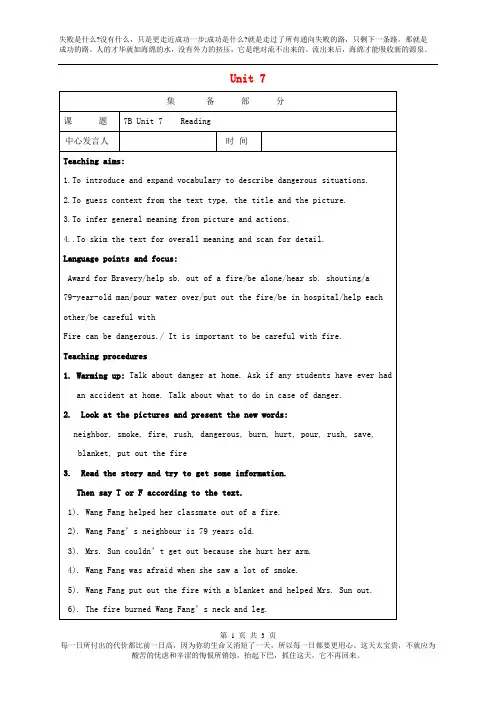
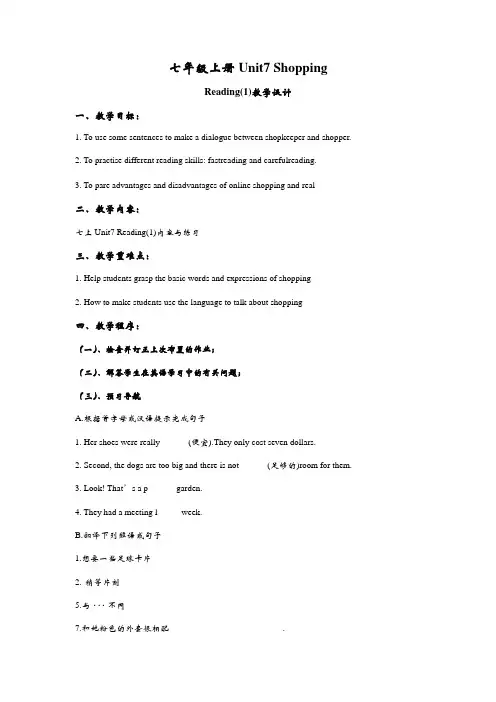
七年级上册Unit7 ShoppingReading(1)教学设计一、教学目标:1. To use some sentences to make a dialogue between shopkeeper and shopper.2. To practise different reading skills: fastreading and carefulreading.3. To pare advantages and disadvantages of online shopping and real二、教学内容:七上Unit7 Reading(1)内容与练习三、教学重难点:1. Help students grasp the basic words and expressions of shopping2. How to make students use the language to talk about shopping四、教学程序:(一)、检查并订正上次布置的作业;(二)、解答学生在英语学习中的有关问题;(三)、预习导航A.根据首字母或汉语提示完成句子1. Her shoes were really ______(便宜).They only cost seven dollars.2. Second, the dogs are too big and there is not ______(足够的)room for them.3. Look! That’s a p______ garden.4. They had a meeting l_____ week.B.翻译下列短语或句子1.想要一些足球卡片___________________2. 稍等片刻_________________5.与···不同__________________7.和她粉色的外套很相配__________________________.(四)合作探究Lead inStep 1: A dialogue with students.Make a easy dialogue about going shopping.Step 2: Free talkAsk the students what presents they would like to buy at Christmas.Step 3: Leading inIntroduce Amy’s Christmas presents .Step 4: Fastreading1. Where is Amy?2. What is Amy buying?Step 5: Carefulreading1. Dialogue 1: Read and fill in the blanks.2. Dialogue 2: Read and answer questions.3. Finish part B2 on P83T or F .4. Read and fill in the blanks.5. Finish part B3 on P84.(五)巩固拓展Step 6: Consolidation1. Act outScene 1&2Role play2. Read a new material about online shopping and answer questions.Step 7: PostreadingTalk about advantages and disadvantages of online shopping and real shopping. Step 8: Testing in classFinish a test in class and hand in.五、课堂练习:(一)、单选题(每空5分,共50分)( )1.How much _______ the apples _______?A. does, takeB. do; takeC. do; costD. does; cost( ) 2. —Hello, ________?—I am looking for a sweater for my daughter.A. how are youB. who are youC. can I help youD. what are you looking for? ( ) 3. Those flowers ______ Kate $56.A. payB. takeC. costD. spend( )4. Each girl in the class _____ singing. Listen!They’re singing now.A. likeB. likesC. likingD. to like( )5. My shoes _______my trousers.A. matchB. is withC. matchesD. are match( )6.Here _________ different kinds of things in this shop.A. haveB. isC. areD. has( )7. I like the camera. _________ is it? 100 dollars.A.How oftenB. How manyC. How longD. How much( )8. I don’t like this pair of shoes, can I have a look at another _________ ?A.oneB. onesC. pairD. pairs( )9. She likes drinking some water after __________.A.swimsB. swimmingC. swimD. to swim( ) 10. Do you think it is easy _________ the bird in the tree ?A.to lookB. seeC. to seeD. look二、阅读理解(每题5分,共50分)Mason’s Clothing Store( ) 1.—Which is the cheapest(最便宜的)of all? —________A. Shoes.B. Tshirt.C. Pants.D. Skirt( ) 2.—How much are two skirts and a cap? —_______A. $20.B. $21.C. $22.D. $14.( ) 3. You can buy _______.A. blue pantsB. a blue skirtC. a green capD.a black Tshirt( ) 4. You like red and you only have $6. You can buy_______.A. a skirtB. a capC. a TshirtD. a Tshirt( ) 5. You only have sixteen dollars. You can buy_______.A. a skirt and a pair of pantsB. two Tshirts and a pair of shoesC. a skirt and two pairs of shoesD. a cap and a pair of pants六、课后作业Finish some exercise and remember new words in this lesson.。
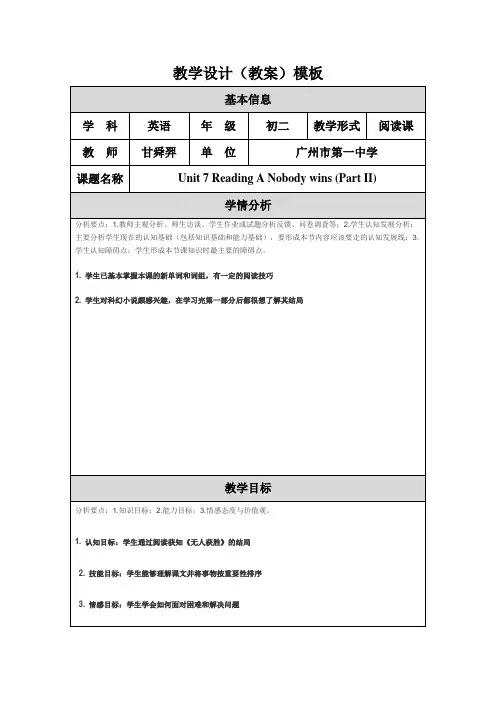
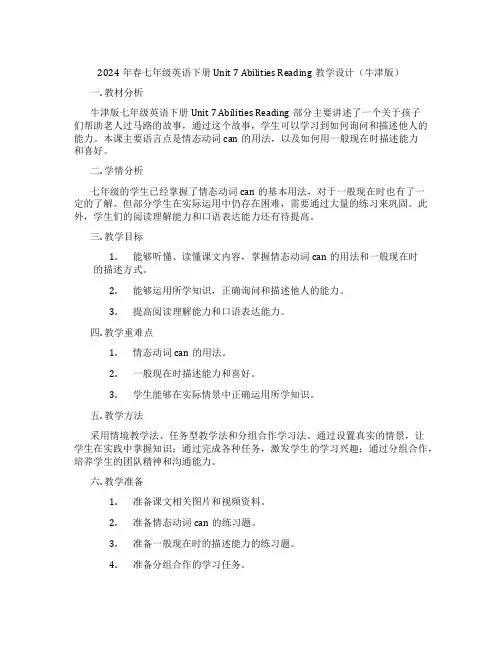
2024年春七年级英语下册 Unit 7 Abilities Reading教学设计(牛津版)一. 教材分析牛津版七年级英语下册Unit 7 Abilities Reading部分主要讲述了一个关于孩子们帮助老人过马路的故事,通过这个故事,学生可以学习到如何询问和描述他人的能力。
本课主要语言点是情态动词can的用法,以及如何用一般现在时描述能力和喜好。
二. 学情分析七年级的学生已经掌握了情态动词can的基本用法,对于一般现在时也有了一定的了解。
但部分学生在实际运用中仍存在困难,需要通过大量的练习来巩固。
此外,学生们的阅读理解能力和口语表达能力还有待提高。
三. 教学目标1.能够听懂、读懂课文内容,掌握情态动词can的用法和一般现在时的描述方式。
2.能够运用所学知识,正确询问和描述他人的能力。
3.提高阅读理解能力和口语表达能力。
四. 教学重难点1.情态动词can的用法。
2.一般现在时描述能力和喜好。
3.学生能够在实际情景中正确运用所学知识。
五. 教学方法采用情境教学法、任务型教学法和分组合作学习法。
通过设置真实的情景,让学生在实践中掌握知识;通过完成各种任务,激发学生的学习兴趣;通过分组合作,培养学生的团队精神和沟通能力。
六. 教学准备1.准备课文相关图片和视频资料。
2.准备情态动词can的练习题。
3.准备一般现在时的描述能力的练习题。
4.准备分组合作的学习任务。
七. 教学过程1.导入(5分钟)利用图片和视频资料,引导学生谈论关于孩子们帮助老人过马路的故事。
提问:你们见过类似的事情吗?你们觉得这些孩子做得对吗?2.呈现(10分钟)呈现课文标题和第一段,让学生猜测课文内容。
然后逐段呈现课文,引导学生跟读并模仿语音语调。
3.操练(15分钟)用PPT展示情态动词can的用法,通过例句和练习题,让学生巩固所学知识。
然后让学生分组,用一般现在时描述彼此的能力和喜好。
4.巩固(5分钟)让学生听课文录音,并回答相关问题。
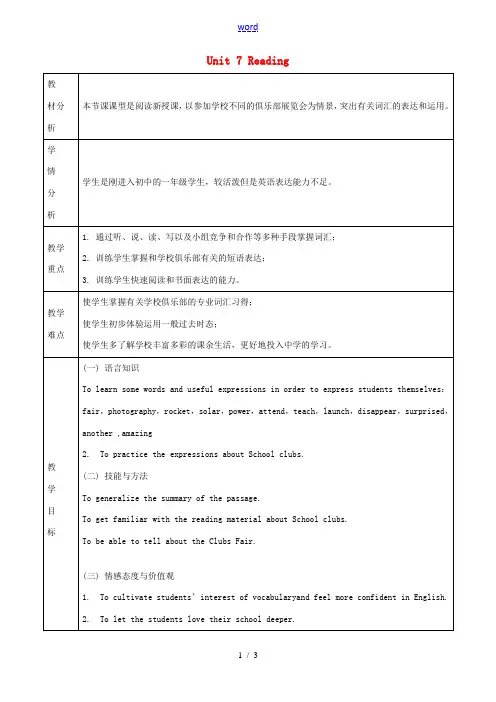
《牛津初中英语》7A Unit7 Going ShoppingReading 说课稿Good afternoon, ladies and gentlemen. My name is I come from Liubao secondary School. Today I’m going to talk abou t how to teach an article about ”Going shopping?”I will divide the instruction into seven parts:they are Teaching material Analysis, Teaching aims, Teaching emphasis, Teaching difficulties, Teaching methods, Teaching aids and Teaching procedures.Part 1 Teaching material analysisThis period is from Unit 7 of 7A Oxford English. First of all, I’d l ike to talk about my understanding about this lesson. We have learned Festivals in Unit 5 and all kinds of food inUnti6. They are about colourful life in module 2. Today we are going to learn two dialogues about how to go shopping. So this unit links with a special meaning of Unit 5 and Unit 6.This period is the first lesson of Reading. We are going to learn the ways to go shopping. So this period is very important in this unit.Grade 7 students are active in class and willing to take part in activities. Their motivation [ˌməʊtəˈveɪʃən]动机;动力for reading can be easily aroused through the contact[ˈkɔntækt]接触with various activities, let alone an article which is closely related to their life experiences. However, they are lack of necessary reading strategies策略, which may affect their reading speed or interest in the long run从长远来看. So it is important to help them master some reading strategies, thus因此developing a good habit of reading.Part 2 Teaching aims1.Aims of the knowledge:Students can recite the important words, phrases and sentences.1.key words:cost, match, enough, change.2.key phrases:just a minute, take a look ,different kinds of .different from3. Target sentences:Can I help you?How much do they cost ?What can I do for you?They match her pink coat.Here’s your change.I’ll take them.2.Aims of the abilities:(1)When students go shopping, they can describe their own need.(2)They can catch the information of shopping from the dialogue.(3)To guess the meaning of the new words by looking at the pictures.(4)Students can assess [əˈses]评定themselves and others properly.(5)Students’cooperative [kəuˈɔpərətiv]ability can be cultivated改善[ˈkʌltiveit]by completing tasks in groups.3.Aims of the emotion:(1)Students’ interest in reading can be promoted.提升(2)Students’ self-confidence in speaking English can be built up.(3)Students can form a based life skills towards going shoppingPart 3 Teaching emphasis1.Key vocabulary2.To train students’ reading comprehension.[ˌkɔmpriˈhenʃən]理解3.To use the conversation [ˌkɔnvəˈseiʃən]交谈会话in the specific [spiˈsifik]context.[ˈkɔntekst]具体上下文Part 4 Teaching difficulties1.To learn how to find out useful information according to scan the context.2.Make conversations about shopping.Part 5 Teaching methodsIn this topic, I will use Task-based teaching approach [əˈproʊtʃ] 任务型教学法,Communicative[kəˈmju:nɪˌkeɪtɪv, -kətɪv]teaching approach 交际教学法and Cooperative teaching method 合作教学法. I design some tasks to help the students learn. I think if I want to improve the students’ oral English,I should give them enough chances to practice and I will use pair work, group work to let the students take an active part in all kinds of activities. That is “Learning by doing, learning by using” .Let the students be the masters of the class teaching, thus, student-centered teaching method is well shown.Part 6 Teaching aidsmultimedia,[ˌmʌlti:ˈmi:di:ə, -taɪ-] tape recorder[riˈkɔ:də] and blackboardPart 7 Teaching procedure [prəˈsi:dʒə]StepⅠ. Warm up and lead inLet students watch a video about jingle bells and have a free talkT: Christmas day is coming? Are you happy? How can we celebrate it ? what present do you want to get? How can we buy some presents for our friends?(The purpose is to arouse the students’ interest of study.)Step Ⅱ.Pre-reading1.Present new phrases about this part , such as hair clip, shopper keeper , cost ,pretty, pink , matchT: Today , in our class Yuanyuan is on duty. Now let’s look at her. She is very pretty because she is in pink. And she also has a hair clip on his head. They match well with each other. Do you like her hair clip? Do you want to know how much this hairclip cost? Now you can ask the shopkeeper in the supermarket.2.Lead students to read new phrases3. Practice these new phrases by matching the words and phrase in part B1(The purpose is to help the students solve some problems before reading. New words have already appeared, so the teacher informs [inˈfɔ:m] 通知the students of more collocations [ˌkɔləˈkeiʃənz]排列of the new words, which are helpful for students' reading and speaking later. Reading the new words after the teacher can help improve students' pronunciation [prəˌnʌnsiˈeiʃən] and intonation.)Step Ⅲ.While-readingTask1:skimming1.Where is Amy now?2.What presents does Amy buy for Simon and Sandy ?( The purpose is to develop the skills of skimming and how to gain the main idea of the articles. Reading quickly is one kind of reading strategies, which needs students to find out the information within a short time. )Task 2:Listen to the first part and fill in a tableTask 3:Listen to the second part and decide the following sentences are true or false (do part B2)Task 4:Intensive Reading: Read and choose (do part B3 1-4))Task 5: Solve the problem (do part B3 5-6)(The purpose of these parts is to develop the skills of scanning and how to gain the details from the articles. And these tasks are the most important parts of this lesson. Whether it is understood thoroughly decides students' performance later.)Step Ⅳ.Post-readingTask6:Task-based reading(每空一词)(The purpose is to help Students be more familiar with the text by completing this task and help them do better in any exam in the future.)Task7: Practise reading the two dialogues and cooperate [kəuˈɔpəreit]with their partners. Have a discussion :how to be a Shopkeeper/customer?Let them to write down some useful sentences.1.Can I help you ?2.What can I do for you?3.Just a minute .There are some…over here.Take a look.1.I am looking for …2.I want to buy…3.How much do they cost?(The purpose is to Practice what students have already learned. It also improves students' ability in making sentences. And it can also train the students’cooperative ability)Task7: Have a group competitionDivide the students into six parts and have a competition .Let ss make new dialogues according to different shopping experiences and go on practice shopping .(In this part, a competition is effective enough to stimulate [ˈstimjuleit]激励students' interest. Limited time will make this game more competitive. [kəmˈpetitiv] )Step Ⅴ.Extension[iksˈtenʃən]延伸and homeworkTask8 Let the students discuss:(!) If I have much pocket money, I want to …(2) How to use pocket money correctly?(The purpose is to give the students a clear idea of how to do shopping and how to use their pocket money and let them know the importance of saving money)Task9 home work1.Recite the new words and phrases.2.Make a new dialogue about shopping.3.Make a reasonable[ˈri:zənəbl] plan about how to use packet money.(Homework is an extension of the previous lesson. Reciting the text can help students develop the sense of language. Designing a plan calls for students' creativity,[ˌkri:eɪˈtɪvətɪ] imagination and show their personality.)During my teaching,I’ll try my best to get my class alive and encourage the students to talk with each other in English. I think the general aim of English teaching is to improve the ability of using English. And I’ll use this to guide my teachi ng.Thank youBlackboard design。
2020年牛津译林版七年级英语下册Unit7Reading教案Unit 7 Reading 教案Step 1:Words:1.Learn some new words after the pictures.2.Read the new words together.3.T: Daniel is reading a newspaper article about fire, but there are some difficult words. Let’s learn the words with him. Match the words on the left with the meaning on the right.Step 2 Lead-in:1.T: Fire is very important for us in our fire. What can we use it for?S: We can use it to make water hot, keep us warm, give us light and cook food.2.T: Fire is useful, but it can also be very dangerous if you’re not careful with it. It can burn things or hurt people. A big fire can even burn forests and tall buildings, so keep yourself away from fire.If there is a fire, what should we do?S:1.You should call 119.2.Rush out of the fire as quickly as you can.3.Shout for help.4.Pour water over the door.5.Put a wet blanket over the body.Step 3 Pre-reading:T: What happened to the little boy?S: He is ill./ He hurt himself.T: Can you imagine who, what ,where, why about the story?S: who The 79-year-old Mrs Sunwhat save his neighbour from a firewhere at home alonewhy hear someone shouting “fire,fire,help”T: Never mind. Let’s read a newspaper articl e about a fire to get the detailed information./T: Do you want to know more about him?S: Yes.Step 4 While-reading:1.T: Today we’ll read a newspaper article about a fire and a brave young man. Now let’s watch a flash and answer the questionWhat did the young man do?He saved his neighbour from a fire.2. Fast readingNow please read the story on your own, and decide whether the following statements are true or false. ( F )Lin Tao helped his grandma out of a fire. neighbour( T ) Mrs Sun couldn’t get out because she hurt her left leg.( F ) Mrs Sun was in her bedroom when the fire took place. kitchen( F )Lin Tao came and put out the fire. Some firemen( F )The fire burnt Lin Tao’s neck, arms and legs. Faces( T )Many people visited him and brought him flowers and presents.3. Detailed reading:Here are some questions about the story. Read through the story to find the answers.1.When did the fire happened? On 10th May.2.Was there a lot of smoke? Yes, there was3. Why couldn’t his neighbour Mrs Sun get ou t?She couldn’t get out because she hurt her leg.4. How long was he in hospital? He was in hospital for two weeks.5. What did many people say to Lintao? How brave you are!Step 5 Consolidation:Read the text together and fill in the blankets.Lin Tao is a b______young man.He s_____his neigbour Mrs.Sun from a f_____.On 10th May,he was at home a_______. Suddenly he heard someone s______‘Fire!Fire!’he saw a lot of s______ from n____ ____.He p_____ water over his clothes to protect himself.Then he r_____ into his neighbour’s kitchen and put a wet b_____over her. He helped her out.But the fire b____ him. He was __ _____ for two weeks.Many visitors g_____ him some flowers and Lin Tao said that fire can be very d________. It is i_____ to be ______ with fire.Step 6 Play a game: Choose the letter and then tell true or false statements:T: There are three groups in our class. In each group I will ask three students to choose and answer then let’s look at which group will win.1.Wrong can’t play with matches.be caref ul with matches.2.Right When there is a fire , we should call 119 at once.3.Wrong We can’t put anything hot into the rubbish bin.4. Wrong We can’t leave the stove on when we are not at home.5. Right When there is a fire, we should use the stairs instead of a lift.6. Wrong keep long hair away from fire.7.Wrong We can’t smoke in bed.8.Right When there is a fire, we should cover our bodies with wet blankets and rush out of the flat quickly.9.Wrong We can’t jump down from the building. Jumping may be more dangerous than the fire.Step 7 Disscusion:What can we learn from Lin Tao?When you find your classmate ill at school…When you see someone hurt in the street …Fire is useful , but it is also dangerous.It is important to be careful with fire. And we should help each other.Proverb(谚语): To help others is to help ourselves!帮助别人就是帮助自己!Step 8. Homework:1.Retell the text of reading2.Do Part B1 and Part B3 on Page 83-84.7B Unit 7 Reading 教案Step 1:New Words:1.Learn some new words after the pictures.2.Read the new words together.3. Match the words on the left with the meaning on the right.Step 2 Lead-in:1.What can we use it for?2. If there is a fire, what should we do?Step 3 Pre-reading:What happened to the little boy?Step 4 While-reading:1.No w let’s watch a flash and the question:What did the young man do?2.Fast reading: Now please read the story on your own, and decide whether the following statements are true or false.3.Detailed reading:Read the story to find the answers.Step 5 Consolidation:Read the text together and fill in the blankets.Lin Tao is a b______young man.He s_____his neigbour Mrs.Sun from a f_____.On 10th May,he was at home a_______. Suddenly he heard someone s______‘Fire!Fire!’he saw a lot of s______ from n____ ____.He p_____ water over his clothes to protect himself.Then he r_____ into his neighbour’s kitchen and put a wet b_____over her. He helped her out.But the fire b____ him. He was __ _____ for two weeks. Many visitors g_____ him some flowers and Lin Tao said that fire can be very d________. It is i_____ to be ______ with fire.Step 6 Play a game:Choose the letter and then tell true or false statements:Step 7 Disscusion:What can we learn from Lin Tao?Proverb(谚语)To help others is to help ourselves!帮助别人就是帮助自己!Step 8. Homework:1.Retell the text of reading2.Do Part B1 and Part B3 on Page 83-84.。
阅读课教学设计设 计 人: 课 题:牛津英语上海版,七年级下册,Unit 7 Food and drinks教学内容:Reading A Eating in different ways 课 型:阅读课教学时间:40 分钟 教材分析: 本单元的主题是谈论“食物和饮料” ,是学生比较感兴趣的话题。
本课是本单元的第一 课时,阅读材料是关于中外饮食文化的语篇。
本课出现的课标词汇共 7 个,拓展词汇共 2 个,重点短语 1 个,拓展短语共 2 个。
学情分析: 1. 学生对“食物和饮料”这个主题会比较感兴趣,贴近学生的生活,容易唤起他们学习的 兴趣,他们对此也有话可说,有利于引导他们进行深入的思考与探讨。
2. 通过初中一年的学习,学生已具备一定的阅读理解能力,掌握一些阅读理解的策略与技 巧,借助本课的阅读理解活动进一步巩固、运用已学的策略与技巧,以提高学生的阅读理解 能力。
但学生对语篇的结构意识不是很强, 可以渗透一些这方面的指导。
教学目标: 1. 认知目标: 重点 词汇 词组 拓展 词汇 单词 词组 单词 ☆ several, knife, dish, raw take off smelly, sashimi cut into, have trouble doing something☆☆ spoon, fork, chopstick ☆2、 能力发展目标: 1)通过多种形式的阅读活动与任务,指导学生进一步巩固、运用已学的阅读理解策略与技 巧,培养一些阅读微技能,如:搜寻细节信息、概括段落大意、寻找中心句等,从而提高学 生的阅读理解能力。
2)帮助学生建立初步的语篇结构意识。
3)培养学生探究学习、合作学习、自主学习的能力。
3、情感目标: 1. 了解不同国家的特色食物、餐具与用餐习惯。
2. 学会尊重其他国家的饮食传统。
教学流程设计: 步骤 1. Warming up目的 Stimulate students interest learning food. in教师活动 Show some pictures of Recall学生活动 some food words as quickly as possible.条件/手段 multimedia multimediaTo teach a few words in the text. To prepare the students for what they are going to read. Show Ss picture on page 98 and ask Ss to fill in the blanks. Ss can discuss their answers in groups. 2.Fast-reading To train the students to use the title, the picture and their prior knowledge to anticipate the content of the text. To get students to anticipate the content of the text. through discussion.Learn a words.fewnewSs discuss the pictures on page 98 and complete the sentences in groups.textbookTry to predict based on the title and pictures of the text. textbook(1)Guidestudents the mindread the passage and complete To train the students to skim through a text and help them to identify and think about the main ideas of the passage. map. (2)To get students to skim the text to identify the general ideas of Paragraph2,3,4 of the passage. (3)Guide the students to pay attention to the structure of the passage. To get students to know more about the details of the passage, finish exercise 2, task 2 on Students’ sheet.To skim the passage, then finish exercise 2,task 1 on Students’ sheet.textbook, Students’ sheet.3. While-readingTo help students to reach a detailed understanding of the passage.To finish exercise 2, task 2 on Students’ textbook sheet.. ,Students’ sheet4 Post-readingTo learn more about food culture of foreign countries. To help students to consolidate what they have learnt。
Get the students work in groups to introduce some eating habits between China and other countries.To work in groups to introduce some eating habits between China and other countries5. Homework1、 Listen to the text and read it after the tape. 2、 Recite the new words and phrases 3 、 Make a copy of English handwritten newspaper about different eating ways in different countries. (Group work).Students’ Sheet Unit7 Reading A 1. Fast-reading:Task 1: Read the passage, choose the best answer: The passage is mainly about _______________. A. people’s favourite food B. what people use to eat with C. eating habits in different countries Task 2: Read the passage for the third time and fill in the table:Country Eating ToolsName:____________China Japan the UKUse__________ or __________ Use ____________ Use __________ and _____________2. While-Reading:Task 1: Read the passage paragraph by paragraph and complete the mind map.China1. 2. 3. 4. People help themselves with __________. Cooks cut the food into ____________. People put _____ on different plates. The hostess puts the food ________________the table.Japan1. 2. 3. People use _________ to eat with. People do not get the food like Chinese, they put the food in ______________. ________ is their favourite food.The UK1. The people put the food ______________ the table and ________ the food around. 2. People use their _________ to cut the food and their ________ to eat.Task 2: Read the passage carefully and circle True or False on page 99. 1. People in China and Japan do not use spoons. ( ) 2. Some people have trouble using chopsticks. ( ) 3. People in the UK do not usually eat chicken’s feet or smelly tofu. ( ) 4. In Japan, people help themselves from plates of food in the middle of the table. ( ) 5. Most people in the UK use chopsticks. ( ) 6. In the UK, the cook cuts the food into small pieces. ( ) 7. In the UK, people help themselves to the food in the middle of the table.( )3. Post-ReadingTalk Bar: Talk about the differences of eating habits between China and other countries.Homework 1. Recite the new words of 7R on P116. 2. Read the passage after the recording. (3 times) 3. Write a short passage about this lesson. 课后练习: Choose the phrases to complete the sentences: have trouble speaking Chinese, take off, cut… into 1)He often ________ vegetables and fruit _________ small pieces to make salad. 2)Please _______ __________ your coat. It’s too hot. 3)They _________ __________ __________ ___________. They aren’t Chinese, they come from America.。